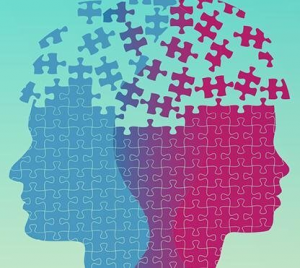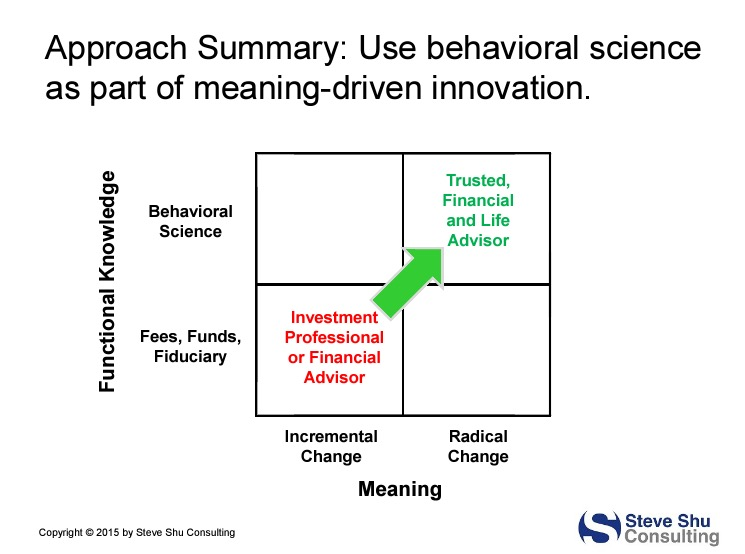Nudging and Behavioral Architecture
How Do Behavorial Scientists Think We Should Deal With Reason And Emotion In Our Decisions?
The balancing act is tricky, and I think context and desired outcomes matter. For example:
 A thirty-year old might have problems saving for retirement because they think of savings as being for stranger. The solution might be to increase emotional connection between the thirty-year old and their future self so that the right behavior of saving can be achieved.
A thirty-year old might have problems saving for retirement because they think of savings as being for stranger. The solution might be to increase emotional connection between the thirty-year old and their future self so that the right behavior of saving can be achieved.- A person might be emotionally attached to their home and as a result, they might try to sell their home at too high of a price. It might be better if they can loosen their emotional attachment and feelings of endowment. Getting 3rd party perspectives might be helpful to the seller in terms of distancing themselves so they can set a reasonable market price.
- Sometimes it’s hard to control emotions and desire, and people may try to precommit to a state so that proper decisions are more likely to be made in spite of the situation. I have heard of behavioral economists pouring salt over desserts at dinner (after they’ve had a few bites to get the taste) so they are less inclined to eat the whole thing.
The main takeaways are that there are essentially “two minds” at work, and they work in concert in different ways. Sometimes you need emotion. Sometimes you want less of it. Sometimes you can’t really change your emotions so you need self-control devices and external perspectives. Other times you need to try to slow down thinking. There are many different approaches.
This post is based on an answer to a question posed on Quora.
What Could Be the Relationship Between Design, Behavioral Sciences and Innovation?
One concept that I describe in my recent book, Inside Nudging: Implementing Behavioral Science Initiatives, draws from Roberto Verganti. He uses the term, “Design-Driven Innovation.” I re-coin the concept as “Meaning-Driven Innovation” to ease the explanation a bit. The concept is that in order to innovate under such a framework, one needs to change the relationship between the product or service and the end user. In this framework, the designer must address the question, “what does the product or service mean to the end user?”
In my book, I describe how colleagues and I created an app to help retirees plan for their retirement journey with guidance from a financial advisor. This effort involved equipping financial advisors with some software tools (informed by the behavioral sciences) that they could use with retirees to help the retirees discover blindspots, form priorities and deal with cognitive/emotional difficulties, and reflect on risks more thoroughly. The upshot of our design approach was to try to change the relationship between the advisor and retiree. We wanted the advisor to mean more to the retiree than just a person involved with fees, funds, and fiduciary responsibility. We wanted advisors to evolve to become trusted financial and life advisors. See a figure from my book below:
The meta meaning that we played to one was about connection, creating a new connection between the advisor and retiree. There are other meta meanings to describe relationships with products and services though. For example, there can be products that help to transform people. Or there can be products whose design and meaning are to protect. Or products can be designed to make a person feel more in control.
In summary, one possible relationship between behavioral science, design, and innovation is about changing the meaning between products/services and people through use of behavioral science principles (whether these principles come from psychology, behavioral economics, or the like).
This post has been cross-posted as an answer to a question posed on Quora.
Wilde Agency Interview With Steve Shu: Nudging, Behavioral GRIT & The Effort It Takes
The Wilde Agency graciously interviewed me regarding behavioral economics and
perspectives from my new book, Inside Nudging: Implementing Behavioral Science Initiatives. The interview is on the Wilde Agency blog. Special thanks to Joseph Sanchez @Wilde_Agency for facilitating the interview and getting everything to come together.
I’ve finally released Inside Nudging: Implementing Behavioral Science Initiatives
Inside Nudging is written for management professionals and scientists to feed their thinking and discussions about implementing behavioral science initiatives (which includes behavioral economics and finance) in business settings. Situations include the incubation of innovation centers, behavioral science overlay capabilities, and advancement of existing organizations. Companies need to develop grit – the ability and fortitude to succeed. The book introduces the Behavioral GRIT™ framework and covers key takeaways in leading an organization that implements behavioral science. Behavioral GRIT™ stands for the business functions related to Goals, Research, Innovation, and Testing.
The chapters are complemented by an appendix which covers ideas to introduce behavioral science initiatives. I argue that first a company needs to identify its goals and identify what type of predominant organization model it wants to pursue. There are five predominant organizational models I’ve seen. I also offer that a company should consider a number of implementation elements that may play a role during execution. Example elements include an advisory board and a behavioral science officer.
Note that the purpose of this book is not to teach people about behavioral science; there are many other books out there for those purposes. That said, Inside Nudging introduces some behavioral science concepts to provide context and help develop a common language between management professionals and scientists.
I see the application of behavioral science as still being in the early adoption phase. Many companies will benefit if they take time to develop the right approach. I hope Inside Nudging helps you with your journey.
Steve Shu
Navigating Behavioral Science Applications
The concept of nudging and more specifically the behavioral science phrase of “no neutral design” has strong historical ties to social and public sector issues. The motivation for the phrase goes something like this. We have to provide people with information and choices, such as part of governing a country and during driver’s license application processes, social security claiming processes, and hundreds (possibly even thousands) of other processes. During those processes, we present information and choices as part of designs, and there is some nudging which may influence people’s perceptions and choices in predictable ways. For example, when presenting a set of choice options in list format, a cognitive bias known as the primacy effect may be observed where people tend to be influenced more by the first option in the list. But some option has to be first in the list. So in this case we cannot totally avoid the risk of primacy effect biases. And more generally, we cannot avoid many other types of biases and influences studied in behavioral science. All forms of structure and designs affect behavior. Hence, there is no neutral design, and we need to be deliberate about the behavioral architecture surrounding the way things are designed.
These considerations also play a role in the private sector. And I see a lot of cases where companies may not be conscious about how behavioral science influences come into play simply because they weren’t thinking about them. And that’s the problem. It is a corollary to no neutral design. Because we design things in the private sector, we influence behavior. We can either be diligent to consider behavioral science considerations or not. In other words, we need to avoid accidental behavioral architecture in our designs. We need to navigate toward deliberate behavioral architecture.
Now we can’t predict how everything will turn out for a design through understanding behavioral science. However, we can get a lot smarter about things and about how to manage companies that can better implement and navigate behavioral science. That’s why I’m writing the book, Inside Nudging: Navigating Behavioral Science Applications. The book is not intended to explore detailed behavioral science principals as covered in other great books like Thinking, Fast and Slow (Kahneman 2013) or The Last Mile (Soman 2015). My real focus is to shed light on how behavioral science concepts are implemented in companies and how to get an organization further along the maturity curve in terms of implementation. These management considerations sometimes require a more detailed appreciation of behavioral science. For example, it is hard to really explore management considerations of behavioral science and ethics without delving into areas like System 1 versus System 2 thinking, nudge controllability, moral psychology, and the like. To implement behavioral science more effectively, companies need grit – the ability and fortitude to succeed. Behavioral GRIT™ is a key framework that I refer to in Inside Nudging, and it represents orchestrating companies relative to Goals, Research, Innovation, and Testing.
Inside Nudging: The Excerpts is available in paperback form for talks, workshops, and academic inquiries. The excerpt version of the book includes:
- Chapter 1: Behavioral Science Centered Design in the New Black – This chapter both sets the foundation for deliberate behavioral architecture and the lenses that we need to examine company efforts through.
- Chapter 2: Organizations Can Package Behavioral Science for Good – This chapter describes a case of using behavioral finance in the retirement plan design space.
- Chapter 8: Nudges Refined, Ethics Examined, Acceptability Explored – This chapter introduces Nudge Psyche, a checklist of things to think about so that you can be deliberate about how you approach nudge design and ethics.
- Appendix A: Ideas to Introduce Behavioral Science Initiatives – This appendix explores predominant organization models (such as an innovation center) and a number of implementation elements that may play a role during execution (such as an advisory board and a behavioral science officer position).
Thanks for reading. I welcome your companionship on this journey and your feedback. Visit www.InsideNudging.com for more info.
Behavioral Economics and Innovation Workshops
I am co-hosting Behavioral Economics and Innovation Workshops in conjunction with one of my colleagues and partners, Namika Sagara at Sagara Consulting. The goals of these workshops are twofold. First, the workshops teach and demonstrate key behavioral economics (BE) concepts to participants. Second, the workshops provide an introduction to how companies can implement BE initiatives. In-class exercises and a mock innovation setting provide an experiential learning process for internalizing BE knowledge and skills. More information on the workshops can be found here.


